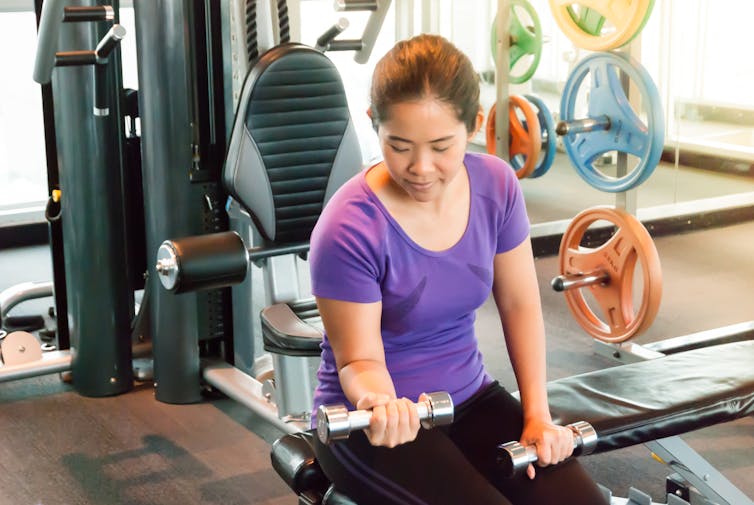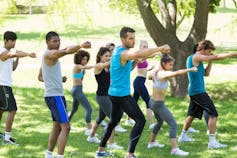Move more, sit less – great advice, but how can we make time for exercise?
The new Physical Activity Guidelines for Americans have just been released, and here is the bottom line: Just move. Bike, walk, run or lift weights. It all counts toward your weekly exercise quota.

It’s that time again. The U.S. Department of Health and Human Services just released a new edition of the Physical Activity Guidelines for Americans. That sound you hear is Americans collectively sighing.
Let’s be honest: Physical activity guidelines can be tough. As behavioral scientists with expertise in exercise motivation, we will be the first to admit that maintaining a physically active lifestyle isn’t easy. This is what we do, and we don’t even always hit the goal. Life is messy and often gets way of even the best intentions. Let’s take a deep breath, unwrap these new guidelines and talk strategy.

The guidelines
The guidelines recommend that all adults do at least 150 minutes per week of physical activity at an intensity that elevates the heart rate. Older adults should add balance exercises. And with the exception of women who are pregnant or nursing, adults should lift weights using all major muscle groups at least twice a week.

The guidelines also recommend that school-aged children and adolescents be active for 180 minutes per week. Preschoolers should be active throughout the day. Right now you might be thinking, who has time for all this exercise?
The good news

The good news is that the guidelines now recognize that fitting in big blocks of time for exercise is not necessary to get health benefits. For the first time, the guidelines don’t require that physical activity occurs in bouts of 10 consecutive minutes or more to be valid. All activity counts. So that climb up and down the stairs at work every day counts toward your goal (as long as you’re raising your heart rate).
The new guidelines also emphasize a “move more, sit less” message to encourage everyone to do just a little more physical activity and to spend a little bit less time sitting. Physical activity isn’t all or nothing. Every little bit comes with health benefits, so if reaching the guideline seems overwhelming, that’s OK. Just try to do a bit more than you did yesterday. Improvement counts as success whether you meet the guidelines or not.
But how? And when?
If you feel the guidelines are overwhelming, you are not alone – this is one of the most common complaints about the guidelines we hear from the thousands of people we have studied and counseled in exercise programs. People often feel hopeless about changing their lifestyle dramatically. One way to tackle a large goal is to break it down into smaller pieces.
Consider a marathon runner. No new runner starts off running 26 miles; each one has to build up to it. They break monstrous goals into smaller pieces that increase steadily over many months. You can approach the new physical activity guidelines in the same way. By tracking your progress, using incrementally more challenging goals, and celebrating milestones of achievement, you can move yourself closer to reaching the big goal.

The first goal you set should be a pretty easy goal – so easy you should be thinking, “Oh, come on! That is too easy!” Say, for example, you get about 30 minutes of exercise per week. Could you increase to 35 minutes per week for the next three weeks? Once you’ve nailed 35 minutes for 2-3 weeks, bump it up to 40 minutes. The idea here is that you are building slowly, getting used to each step before moving onto the next step. Each step is also enhancing your physical fitness and conditioning so the next step won’t feel much more difficult than the one before. From a time management perspective, sneaking in an extra five minutes here and there is also far easier than finding time blocks of 30 to 60 minutes.
If you are far from 150 minutes right now, forget about 150 right now. Come up with a goal that is “Oh, come on!” easy and then go from there. You can track your progress with wearable devices, smartphone apps or good old-fashioned pen and paper. However you track your progress, it is important to have a plan that you can track and keep trying to raise the bar for yourself – ever so gently.
The best thing you can do for your health

The experts call physical activity the “best buy” in public health. And the guidelines are based on evidence from thousands of studies. Based on this evidence, an expert panel concluded that exercise increases our lifespans, prevents that sneaky annual weight gain and reduces the risk of almost every chronic disease: cardiovascular disease, diabetes and many cancers. No other single behavior can do as much good for your health. By investing some time into exercise now, you get to cash in later. Think of it as the 401K for a long, healthy and happy life.
Of course, we don’t always make decisions in our long-term self-interest. We are wired more toward immediate rewards, and many health benefits of physical activity take years to appear. Some may be hard to notice at all, like preventing heart disease.
Fortunately, exercise has many immediate benefits. One of the biggest is the “feel good” effect afterwards. People consistently feel more focused, less stressed and more energized after physical activity. In fact, studies now show that regular physical activity can actually reduce anxiety and depression – with effects equal to antidepressant medication or psychotherapy. We are all just one workout away from feeling better than we do right now.

One word of caution: Be careful not to push too hard too soon. Exercising hard can feel unpleasant. Most people don’t repeat activities that feel unpleasant. Find something you enjoy and keep it fun if you want that behavior change to stick. When you hear all the news about the new physical activity guidelines, try not to let it discourage you. Set the numbers aside for now and just ask yourself, “How can I move a little more and sit a little less than I do now – and how can I make it fun?”
You got this.
David E. Conroy receives funding from the National Institutes of Health and National Science Foundation. He is affiliated with The Pennsylvania State University and Northwestern University.
Sherry Pagoto receives research funding from the National Institutes of Health. She is a paid scientific adviser for Fitbit.
Read These Next
From truce in the trenches to cocktails at the consulate: How Christmas diplomacy seeks to exploit s
World leaders like to talk up peace at Christmastime. But alongside the tales of seasonal breaks in…
How to reduce gift-giving stress with your kids – a child psychologist’s tips for making magic and a
Depending on family circumstances and a child’s personality type, gift giving runs the gamut of fun…
The world risks forgetting one of humanity’s greatest triumphs as polio nears global eradication − 7
Polio may finally be defeated in the next 5 years. Will the world recognize what an extraordinary achievement…






